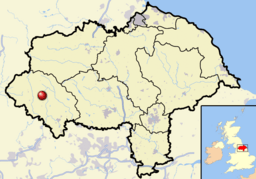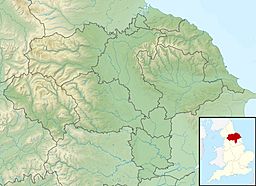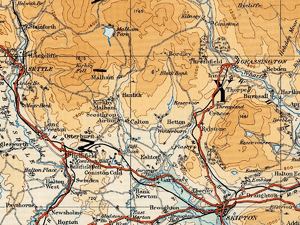Malham Tarn facts for kids
Quick facts for kids Malham Tarn |
|
|---|---|

A view of the north-east corner of Malham Tarn
|
|

Malham Tarn shown within North Yorkshire
|
|
| Location | Yorkshire Dales, England |
| Coordinates | 54°05′45″N 2°10′0″W / 54.09583°N 2.16667°W |
| Type | Glacial |
| Catchment area | 6 km2 (2.3 sq mi) |
| Basin countries | United Kingdom |
| Surface area | 0.62 km2 (0.24 sq mi) |
| Average depth | 2.4 m (7.9 ft) |
| Max. depth | 4.4 m (14 ft) |
| Residence time | 11 weeks |
| Surface elevation | 377 m (1,237 ft) |
| Designated: | 28 October 1993 |
| Reference #: | 634 |
Malham Tarn is a beautiful glacial lake in the Yorkshire Dales, England. A glacial lake is a lake formed by a glacier (a huge sheet of ice) that carved out the land. It's close to the village of Malham.
This lake is special because it's one of only eight "upland alkaline lakes" in Europe. "Upland" means it's high up in the hills. "Alkaline" means its water is not acidic, but more like soap, with a pH between 8.0 and 8.6. At 377 metres (1,237 ft) above sea level, it's the highest "marl lake" in the United Kingdom. Marl is a type of soil or rock that's a mix of clay, silt, and calcium carbonate.
Malham Tarn is very important for nature. Its unique geology (how the rocks and land are formed), flora (plants), and fauna (animals) have earned it many special conservation designations. This means it's a protected area. The National Trust owns the site. They let the Field Studies Council use part of it to teach people about nature.
The lake was also the inspiration for a famous book. Charles Kingsley wrote his 1863 novel The Water-Babies, A Fairy Tale for a Land Baby after visiting Malham Tarn.
Contents
Exploring Malham Tarn's Location
Malham Tarn is found in the Yorkshire Dales, which is a national park in the Yorkshire Pennines mountain range. It's about 25 miles (40 km) north-west of a city called Bradford. The closest village, Malham, is about 2.5 miles (4 km) to the south.
At 377 metres (1,237 ft) above sea level, Malham Tarn is very high up. Some people mistakenly think it's the highest lake in England. However, there are other lakes, like Innominate Tarn, that are even higher. But it is definitely the highest marl lake in Great Britain.
The area that collects water for the lake, called the catchment area, is about 600 hectares (6.0 km2; 2.3 sq mi). The main stream that flows into the lake is in its north-west corner. The lake is 4.4 metres (14 ft) deep at its deepest point. On average, it's about 2.4 metres (7.9 ft) deep. The surface of the lake covers 62 hectares (0.62 km2; 0.24 sq mi). It takes about 11 weeks for all the water in the lake to be replaced by new water flowing in.
The water leaves the lake through a small stream at its southern end. This stream goes underground after about 500 metres (1,600 ft). It then reappears further downstream, becoming a source for the River Aire.
Weather at Malham Tarn
| Climate data for Malham Tarn, elevation: 391 m (1,283 ft), 1981–2010 normals, extremes 1960–present | |||||||||||||
|---|---|---|---|---|---|---|---|---|---|---|---|---|---|
| Month | Jan | Feb | Mar | Apr | May | Jun | Jul | Aug | Sep | Oct | Nov | Dec | Year |
| Record high °C (°F) | 12.5 (54.5) |
15.3 (59.5) |
19.1 (66.4) |
21.0 (69.8) |
24.0 (75.2) |
27.2 (81.0) |
28.0 (82.4) |
28.2 (82.8) |
24.4 (75.9) |
20.1 (68.2) |
15.2 (59.4) |
12.9 (55.2) |
28.2 (82.8) |
| Mean daily maximum °C (°F) | 4.6 (40.3) |
4.7 (40.5) |
6.8 (44.2) |
9.5 (49.1) |
13.0 (55.4) |
15.3 (59.5) |
17.2 (63.0) |
16.8 (62.2) |
14.5 (58.1) |
10.8 (51.4) |
7.3 (45.1) |
5.0 (41.0) |
10.5 (50.9) |
| Daily mean °C (°F) | 2.2 (36.0) |
2.1 (35.8) |
3.8 (38.8) |
6.0 (42.8) |
9.1 (48.4) |
11.7 (53.1) |
13.7 (56.7) |
13.4 (56.1) |
11.3 (52.3) |
8.0 (46.4) |
4.8 (40.6) |
2.6 (36.7) |
7.4 (45.3) |
| Mean daily minimum °C (°F) | −0.3 (31.5) |
−0.5 (31.1) |
0.8 (33.4) |
2.5 (36.5) |
5.2 (41.4) |
8.1 (46.6) |
10.1 (50.2) |
9.9 (49.8) |
8.0 (46.4) |
5.2 (41.4) |
2.3 (36.1) |
0.1 (32.2) |
4.3 (39.7) |
| Record low °C (°F) | −11.5 (11.3) |
−13.0 (8.6) |
−13.5 (7.7) |
−7.5 (18.5) |
−4.2 (24.4) |
−1.1 (30.0) |
1.7 (35.1) |
2.1 (35.8) |
−1.0 (30.2) |
−4.9 (23.2) |
−9.2 (15.4) |
−14.1 (6.6) |
−14.1 (6.6) |
| Average precipitation mm (inches) | 167.1 (6.58) |
120.7 (4.75) |
132.1 (5.20) |
95.3 (3.75) |
86.1 (3.39) |
99.4 (3.91) |
105.0 (4.13) |
128.3 (5.05) |
125.3 (4.93) |
161.0 (6.34) |
157.8 (6.21) |
172.0 (6.77) |
1,550 (61.02) |
| Average precipitation days (≥ 1.0 mm) | 18.0 | 14.4 | 16.0 | 13.7 | 12.8 | 13.6 | 13.5 | 15.3 | 14.0 | 16.9 | 18.2 | 17.4 | 183.7 |
| Mean monthly sunshine hours | 36.8 | 58.0 | 83.2 | 124.9 | 158.3 | 137.4 | 142.8 | 139.8 | 107.5 | 74.8 | 43.9 | 35.4 | 1,142.7 |
| Source 1: Met Office | |||||||||||||
| Source 2: KNMI | |||||||||||||
Nature and Wildlife at Malham Tarn
Malham Tarn is in an area known for its limestone rocks. The lake itself sits on a bed of silurian slate, which is covered by layers of marl. The lake's basin was formed by a natural dam of rock and soil, called a moraine, left behind by a glacier about 10,000 years ago.
The lake used to be twice as big as it is now. It has shrunk over time because silt (fine sand or mud) has built up on its western shore. This has created a boggy area called Tarn Moss. After many trees were cut down during the Iron Age, the land around the lake has been used for grazing animals. This has stopped new trees from growing. In 1791, Lord Ribblesdale added an embankment and a gate to control the water flow. This raised the lake's level by about 4 feet (1.2 m). The area gets a lot of rain, with an average of 1,542.5 millimetres (61 in) each year.
Animals and Plants of Malham Tarn
The lake is home to six types of fish. You can also find white-clawed crayfish here. Many birds live around the lake, including great crested grebes, moorhens, coots, tufted ducks, and teal.
Several types of wader birds, which are birds that wade in shallow water, breed in the surrounding area. These include redshanks, curlews, lapwings, and oystercatchers.
The lake also has two rare types of tiny creatures called benthic copepods: Bryocamptus rhaeticus and Moraria mrazeki. These live at the bottom of the lake. There are also 22 different kinds of molluscs (like snails and slugs). Nine of these are found at their highest altitude in Britain here.
Under the water, you'll find many different aquatic plants. The land around the lake is also rich in plants. Some of these include wild cranberry, bearberry, crowberry, dark-leaved willow, and purple moor grass.
In August 2016, water voles (Arvicola amphibius) were brought back to the area. They had not been seen there for 50 years. This was the highest reintroduction of water voles in the UK.
Protecting Malham Tarn
Malham Tarn is part of the Malham and Arncliffe Site of Special Scientific Interest. This special area was set up in 1955 to protect its unique nature. In 1992, the lake and its wetlands were made a National Nature Reserve. The lake was also listed as a Ramsar Convention site in 1993. Ramsar sites are wetlands of international importance. It is also part of the Craven Limestone Complex Special Area of Conservation.
History of Human Activity at Malham Tarn
People have been active around Malham Tarn for a very long time, going back to the Mesolithic era (Middle Stone Age). Back then, people camped by the lake while hunting deer and wild cattle. During the Bronze Age and Iron Age, farmers settled in the area. They used the land around the lake for grazing their animals.
After the Roman conquest of Britain, the high-up areas were not very popular. The only Roman presence was a temporary camp on Malham Moor. During the Medieval period, the land belonged to monasteries. They continued to use it for grazing. A survey from 1539, when the monasteries were closed down, mentions a farm on the north shore of the lake.
After the monasteries were closed, the Malham Moor estates changed owners many times. Eventually, Thomas Lister, who later became the first Lord Ribblesdale, bought them in the late 1700s. Lord Ribblesdale built a hunting lodge on the old farm site in the 1780s.
In 1852, a businessman named James Morrison bought the estate. When he died, his son, Walter, inherited it in 1857. In 1858, the famous author Charles Kingsley visited Walter Morrison. This visit inspired Kingsley to write his well-known Victorian era novel The Water-Babies, A Fairy Tale for a Land Baby.
Walter Morrison passed away in 1921. The estate was then sold several times and eventually split up. In 1928, Walter Morrison's great-niece, Mrs Hutton-Croft, bought the house and the lake. In 1946, Mrs Hutton-Croft gave the house to the National Trust. The National Trust now manages the property and leases the house to the Field Studies Council. This is now known as the Malham Tarn Field Studies Centre. You can even see the house and the surrounding countryside in the 1951 film Another Man's Poison.
See also
 In Spanish: Malham Tarn para niños
In Spanish: Malham Tarn para niños




